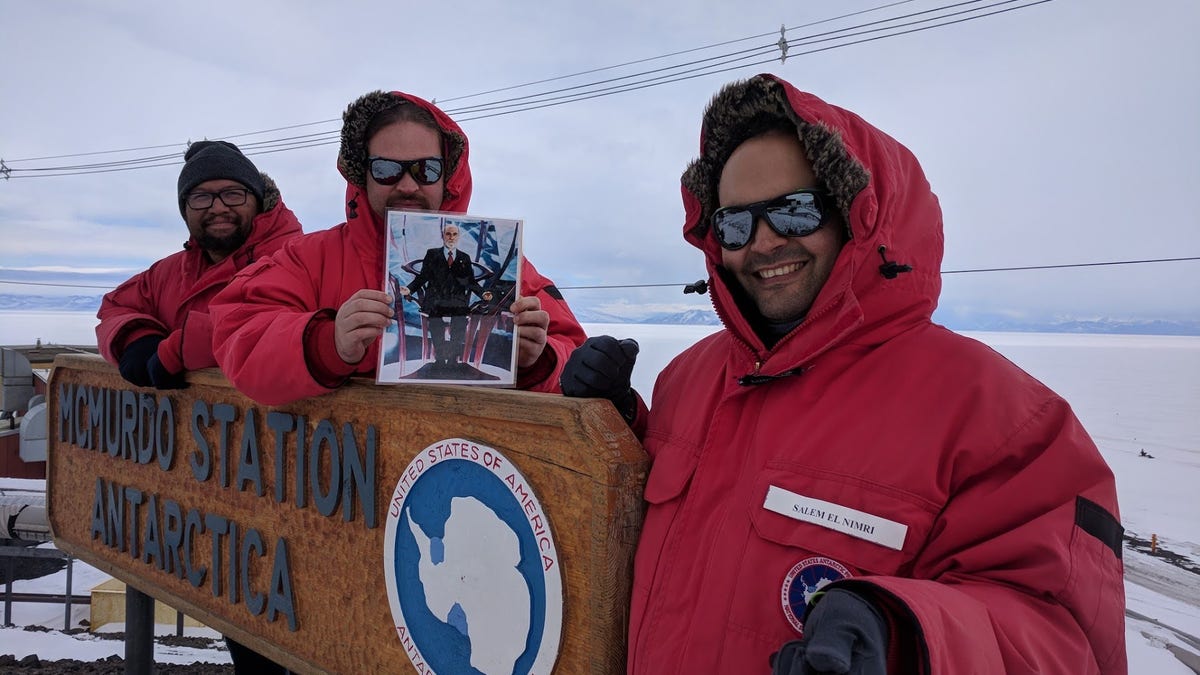
NASA engineers Mark Sinkiat, Peter Fetterer and Salem El-nimri pose at McMurdo Station in Antarctica with a picture of Vint Cerf, a visiting scientist at NASA's Jet Propulsion Laboratory, who helped develop the disruption-tolerant networking (DTN) technology that sent the selfie to the International Space Station. (NASA)
A selfie sent from Antarctica to the International Space Station demonstrated an extra-robust communication network that promises to make an interplanetary internet more reliable. NASA announced the achievement on Monday (Nov. 27).
In space, wireless communication networks are critical. They function as a virtual tether, keeping astronauts and spacecraft in contact with Earth and each other. A network failure could leave something, or someone, dangerously cut off from the resources needed to survive. So far, space missions either directly communicate with Earth or go through only a single relay, like an orbiting satellite, making them especially vulnerable to this problem.
Introducing redundant pathways, in which a signal can get from one point to another in multiple ways, increases the resilience of a system, but this can be difficult to accomplish when a network is still small. What's more, the spacecraft that make up the network don't always have a clear view of each other, so a complete, or end-to-end, connection isn't always available, according to NASA. A traditional network requires an end-to-end path to transmit data. [Dial-Up Space Communications System Gets 'High-Speed' Upgrade]
Alternatively, each node in the network can temporarily store the data that goes through it and wait for the best moment to pass that data along. This kind of system, called disruption-tolerant networking (DTN), allows for small interruptions in connectivity without the loss of information, NASA said. The last node simply sends the remaining bundles of data once the connection has returned. Not only does this ensure that data isn't lost, but it also decreases the time needed to send and receive messages, as NASA illustrates in the video above.
Here's how the picture got from Antarctica to low-Earth orbit. On Nov. 20, NASA engineers took a selfie at the National Science Foundation's McMurdo Station in Antarctica. DTN software on a mobile phone sent the data from McMurdo ground station to NASA's White Sands Complex in New Mexico via the Tracking and Data Relay Satellite system, a constellation of communication satellites. From there, the data traveled through a series of DTN nodes, devices on the network, to NASA's Marshall Space Flight Center in Huntsville, Alabama, which is the access point to the DTN network aboard the space station, according to NASA.
Once the data was beamed up to the space station, it was routed to the Telescience Resource Kit (TReK) demonstration payload. The final DTN node then extracted the photo for the astronauts to see.
Unlike familiar computer-to-computer IP connections, disruption-tolerant networking accommodates temporary disruptions as well as long delays, NASA said in the Nov. 27 statement. These conditions happen in space, but they also occur in remote locations on Earth, like Antarctica, NASA said.
"The Antarctic is an excellent analog for space operations," Patrick Smith, technology-development manager with the U.S. Antarctic Program, said in the statement. "Researchers are conducting important scientific investigations, operating in extreme conditions, with minimal infrastructure, so it's not surprising that we are using NASA space technology to advance science in the Antarctic."
The technology could also have applications in disaster zones, where connectivity is often limited, the statement said.
Original article on Space.com.




















